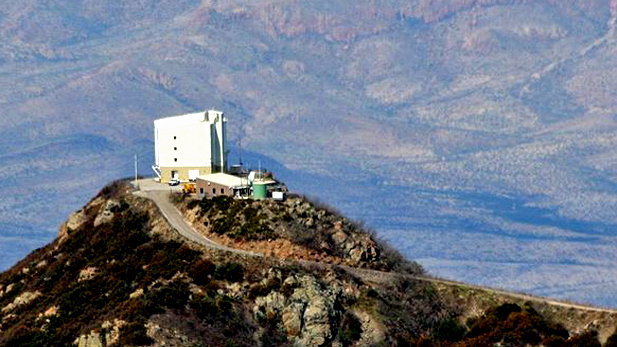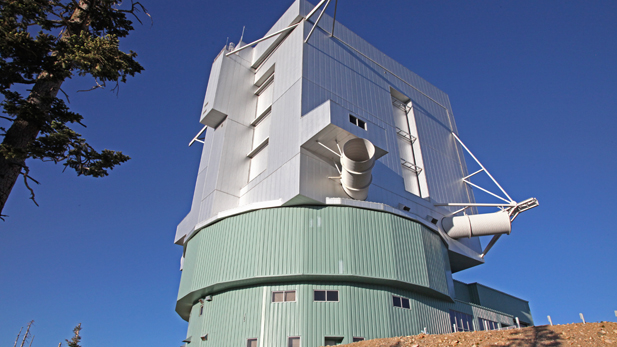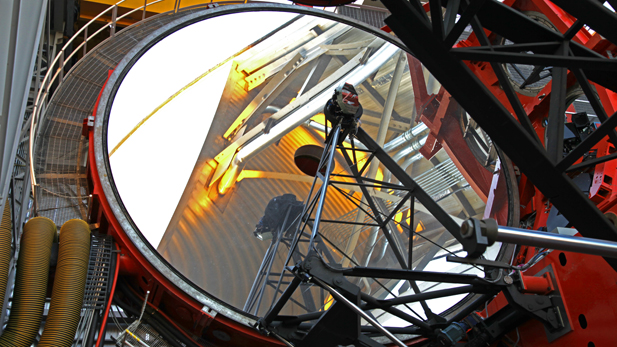The Fred Lawrence Whipple Observatory is located in the Santa Rita Mountains south of Tucson. It's home to a number of telescopes. But the crown jewel sits at the summit of Mount Hopkins. The MMT Observatory. Its primary mirror is 6.5-meters, or 21 feet in diameter, making it one of the largest telescopes in the U.S. The MMTO was the first to be housed in a box-shaped building, instead of the dome traditionally used in astronomy. Its 3-story structure has shutters that open to expose the mirror to the night sky. And the building can rotate 270-degrees.
Dan Brocious, Public Affairs Officer for Whipple Observatory, explains that the MMTO originally had six 1.8-meter mirrors, which is why it was called the Multiple Mirror Telescope when it opened in 1979. The mirror array was replaced by a single mirror in 1998 and the name was shortened to "the MMTO."
 An aerial view of the MMT Observatory on Mt. Hopkins.
An aerial view of the MMT Observatory on Mt. Hopkins.The MMTO was one of the first of a new age of "large" telescopes with mirrors over 5-meters in size. Since its construction, a number of even larger "large" telescopes have been built, including the Hobby Eberly Telescope in west Texas (9.2 meters) and the Keck Observatory telescopes in Hawaii (10-meters each). Most of the new telescopes built in South America in the past 20 years have also boasted large mirror sizes.
The other large telescope in Arizona is the Large Binocular Telescope, or LBT, on Mount Graham in the Pinaleno Mountains of east Arizona. The LBT has twin 8.4-meter mirrors. But according to LBT Director Richard Green, when light from the two mirrors are paired in what's known as "coherence," the LBT's effective size is 22.8-meters. This makes it the largest ground-based telescope in the world. The LBT took its first image of space, or achieved "first light," as astronomers call it, in 2005. But it did so with only one mirror installed. The other mirror is now in place and the telescope began working in "binocular" mode for the first time in 2012.
 The Large Binocular Telescope is housed in a 13-story structure on Mt. Graham.
The Large Binocular Telescope is housed in a 13-story structure on Mt. Graham.Like the MMTO, the LBT is housed in a large, boxy building with giant shutters and a rotating base. Astronomers have found that exposing more of the telescope to the night air reduces warm air currents above and around the telescope, making viewing easier. The box-shaped buildings, unlike domes, achieve this.
Both the LBT and MMTO are part of race to look ever deeper into space. And to do that, we need ever more powerful eyes. Many of the "large" and now so-called "giant" mirrors are being cast and polished at the Steward Observatory Mirror Lab. From a warehouse-sized facility underneath Arizona Stadium on the University of Arizona campus, some of the largest telescope optics in the world are created. The groundbreaking work at the Mirror Lab has enabled astronomers to build larger and larger telescopes. The lab is currently working on an 8.4-meter mirror for the Giant Magellan Telescope (GMT) and an 8.4-meter for the Large Synoptic Survey Telescope.
 The LBT's 8.4-meter mirrors were cast and polished at the University of Arizona's Mirror Lab.
The LBT's 8.4-meter mirrors were cast and polished at the University of Arizona's Mirror Lab.
 The 6.5-meter mirror at the MMT Observatory.
The 6.5-meter mirror at the MMT Observatory.The race for larger mirrors and telescopes could eventually result in mirror sizes now considered impossible. But for now, the race is very much centered in Arizona. Astronomers at the LBT say now that it's operating like a giant "binocular," it could start giving us clearer images of distant star clusters and galaxies than anything else we've ever seen. And the Mirror Lab continues to make the "eyes" for some of the largest telescopes in the world.
Visit the Collecting Light website for more stories, interviews, resources and images.

By submitting your comments, you hereby give AZPM the right to post your comments and potentially use them in any other form of media operated by this institution.